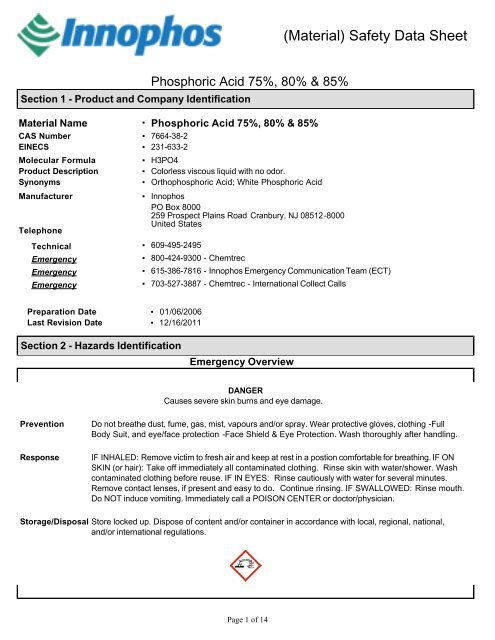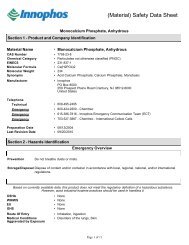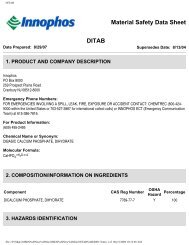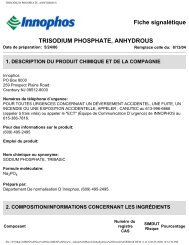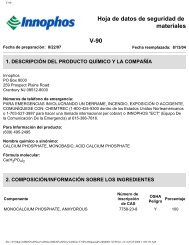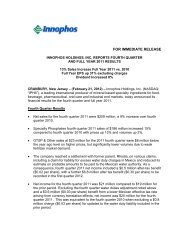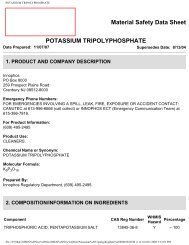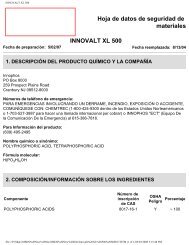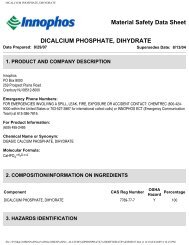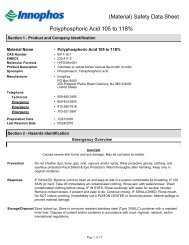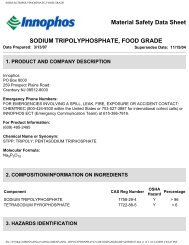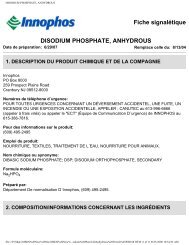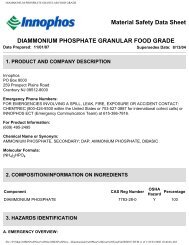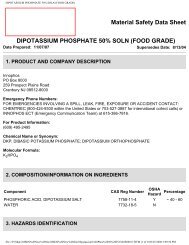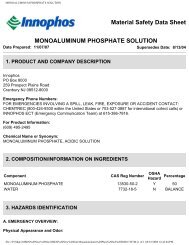Phosphoric Acid 75 80 85 (306.08 KB) - Innophos
Phosphoric Acid 75 80 85 (306.08 KB) - Innophos
Phosphoric Acid 75 80 85 (306.08 KB) - Innophos
Create successful ePaper yourself
Turn your PDF publications into a flip-book with our unique Google optimized e-Paper software.
OSHAWHMIS▪ Corrosive▪ Class E Corrosive materialsEU▪ Corrosive CR34GHSRoute Of EntryMedical ConditionsAggravated by Exposure▪ Skin Corrosion/Irritation Category 1C, Serious Eye Damage, Eye Irritation Category1▪ Inhalation, Skin, Eye, Ingestion▪ Lungs, SkinNFPA:Potential Health EffectsInhalationAcute (Immediate)Chronic (Delayed)SkinAcute (Immediate)Chronic (Delayed)EyeAcute (Immediate)Chronic (Delayed)IngestionAcute (Immediate)Chronic (Delayed)Carcinogenic Effects▪ May cause corrosive burns irreversible damage.▪ Repeated or prolonged exposure to corrosive fumes may cause bronchial irritation withchronic cough.▪ Causes severe skin burns and eye damage.▪ Repeated or prolonged exposure to corrosive materials will cause dermatitis.▪ Corrosive. Can cause permanent damage to the cornea, blindness.▪ Repeated or prolonged exposure to corrosive materials or fumes may causeconjunctivitis.▪ Causes corrosion, burns to mouth and esophagus, abdominal pain, chest pain,nausea, vomiting, diarrhea, seizures. Aspiration of the swallowed or vomited productcan cause severe pulmonary complications.▪ Repeated or prolonged exposure to corrosive materials or fumes may causegastrointestinal distrubances.▪ This product does not contain any ingredient designated by IARC, NTP, ACGIH orOSHA as probable or suspected human carcinogens.Page 2 of 14
Section 3 - Composition/Information on IngredientsHazardous ComponentsChemical Name CAS %(weight) UN;EINECS LD50/LC50<strong>Phosphoric</strong> acid 7664-38-2 <strong>75</strong>% TO <strong>85</strong>%UN1<strong>80</strong>5 (liquid),UN3453 (solid),231-633-2Ingestion/Oral-Rat LD50: =1.25 g/kgInhalation-Rat LC50: =25.5 mg/m³EU Classification& R PhrasesOtherC; R34 NDANon-HazardousComponentsChemical Name CAS %(weight) UN;EINECS LD50/LC50EU Classification& R PhrasesWater 7732-18-5 15% TO 25% 231-791-2 Ingestion/Oral-Rat LD50: >90 mL/kg NDA NDAUnder United States Regulations (29 CFR 1900.1200 Hazard Communication Standard), this product is consideredhazardous. In Canada, the product mentioned above is considered hazardous under the Workplace Hazardous MaterialsInformation System (WHMIS). This product is considered dangerous according to the European Directive 67/548/EEC.According to the Globally Harmonized Standard for Classification and Labeling (GHS) this product is consideredhazardous.OtherSection 4 - First Aid MeasuresInhalationSkinEyeIngestionNotes to PhysicianOther Information▪ Administer oxygen if breathing is difficult. Do not use mouth tomouth method if victiminhaled the substance; give artificial respiration with the aid of a pocket maskequipped with a oneway valve or other proper respiratory medical device. Give artificialrespiration if victim is not breathing. Move victim to fresh air.▪ For minor skin contact, avoid spreading material on unaffected skin. In case of contactwith substance, immediately flush skin with running water for at least 20 minutes.Wash skin with soap and water. Remove and isolate contaminated clothing andshoes. Wash contaminated clothing before reuse.▪ In case of contact with substance, immediately flush eyes with running water for atleast 20 minutes. Seek immediate medical attention, preferably with anophthalmologist. If the physician is not immediately available, eye irrigation should becontinued for an additional 20 minutes. If it is necessary to transport the patient to aphysician and the eye needs to be bandaged, use a dry sterile cloth pad and coverboth eyes.▪ If swallowed give 2 3 glasses of water if victim is conscious and alert. Do not giveanything by mouth to an unconscious person. Do NOT induce vomiting. Obtainmedical attention immediately if ingested. Do not use mouth tomouth method if victimingested the substance. Do not leave victim unattended. To prevent aspiration ofswallowed product, lay victim on side with head lower than waist. Persons attendingthe victim should avoid direct contact with heavily contaminated clothing and vomitus.Wear impervious gloves while decontaminating skin and hair.▪ All treatments should be based on observed signs and symptoms of distress in thepatient. Consideration should be given to the possibility that overexposure to materialsother than this product may have occurred.▪ Call 911 or emergency medical service. Ensure that medical personnel are aware ofthe material(s) involved and take precautions to protect themselves. Keep victim warmand quiet.Section 5 - Fire Fighting MeasuresExtinguishing MediaUnsuitable ExtinguishingMediaFirefighting Procedures▪ Not combustible. Use extinguishing media suitable for surrounding fire.▪ None known.▪ Keep unauthorized personnel away.Dike area to prevent runoff and contamination of water sources. Dispose of fire controlwater later. Evacuate residents who are downwind of fire. Persons who may have beenexposed to contaminated smoke should be immediately examined by a physician andchecked for symptoms of poisoning. The symptoms should not be mistaken for heatexhaustion or smoke inhalation.Page 3 of 14
Unusual Fire and ExplosionHazardsHazardous CombustionProductsProtection of Firefighters▪ Not combustible. Under fire conditions, toxic, corrosive fumes are emitted.▪ Oxides of phosphorus.Noncombustible, substance itself does not burn but may decompose upon heating toproduce corrosive and/or toxic fumes.▪ Structural firefighters' protective clothing provides limited protection in fire situationsONLY; it is not effective in spill situations where direct contact with the substance ispossible.Wear chemical protective clothing that is specifically recommended by themanufacturer. It may provide little or no thermal protection.Wear positive pressure selfcontained breathing apparatus (SCBA).Section 6 - Accidental Release MeasuresPersonal PrecautionsEmergency ProceduresEnvironmental PrecautionsContainment/Clean-upMeasuresProhibited Materials▪ Ventilate enclosed areas. Do not touch damaged containers or spilled material unlesswearing appropriate protective clothing.▪ Keep unauthorized personnel away. Dike spill using absorbent or impervious materialssuch as earth, sand or clay. Dike or retain dilution water or water from firefighting forlater disposal.▪ Prevent entry into waterways, sewers, basements or confined areas. Runoff from firecontrol or dilution water may cause pollution.▪ Exercise caution during neutralization as considerable heat may be generated.Neutralize spill area with soda ash, sodium bicarbonate or lime. Flush neutralized spillwith copious amounts of water.▪ None known.Section 7 - Handling and StorageHandlingStorageSpecial Packaging MaterialsIncompatible Materials orIgnition Sources▪ Do not get on skin or in eyes. Avoid breathing vapors and mists. Do not ingest. Handleand open container with care. Use only with adequate ventilation. Use caution whencombining with water; DO NOT add water to corrosive liquid, ALWAYS add corrosiveliquid to water while stirring to prevent release of heat, steam and fumes. This productreacts violently with bases liberating heat and causing spattering.▪ Store in a cool/lowtemperature, wellventilated, dry place. Store locked up. Keepaway from incompatible materials. Ventilate enclosed areas.▪ No data available▪ Fluorine, strong oxidizing agents, strong reducing agents, bases, metals, sulfurtrioxide, phosphorus pentoxide.Section 8 - Exposure Controls/Personal ProtectionPersonal Protective EquipmentPictogramsRespiratoryEye/FaceHandsSkin/BodyGeneral Industrial HygieneConsiderations▪▪ Follow the OSHA respirator regulations found in 29 CFR 1910.134 or EuropeanStandard EN 149. Use a NIOSH/MSHA or European Standard EN 149 approvedrespirator if exposure limits are exceeded or symptoms are experienced.▪ Wear face shield and eye protection. An emergency eye wash must be readilyaccessible to the work area.▪ Wear protective gloves selected with regard to both durability as well as permeationresistance.▪ Wear protective clothing Full Body Suit▪ Do not get in eyes or on skin or clothing. Wash thoroughly with soap and water afterhandling and before eating, drinking, or using tobacco. Handle in accordance withgood industrial hygiene and safety practice.Page 4 of 14
EngineeringMeasures/Controls<strong>Phosphoric</strong> acid(7664-38-2)<strong>Phosphoric</strong> acid(7664-38-2)<strong>Phosphoric</strong> acid(7664-38-2)<strong>Phosphoric</strong> acid(7664-38-2)<strong>Phosphoric</strong> acid(7664-38-2)▪ Good general ventilation should be used. Ventilation rates should be matched toconditions. If applicable, use process enclosures, local exhaust ventilation, or otherengineering controls to maintain airborne levels below recommended exposure limits.If exposure limits have not been established, maintain airborne levels to an acceptablelevel.Exposure Limits/GuidelinesResult ACGIH Argentina Australia Canada Ontario Canada QuebecSTELs 3 mg/m3 STEL 3 mg/m3 STEL 3 mg/m3 STEL 3 mg/m3 STEV 3 mg/m3 STEVTWAs 1 mg/m3 TWA 1 mg/m3 TWA 1 mg/m3 TWA 1 mg/m3 TWAEV 1 mg/m3 TWAEVExposure Limits/Guidelines (Con't.)Result China Egypt Germany DFG Germany TRGS IndiaSTELs 3 mg/m3 STEL 3 mg/m3 STEL Not established Not established 3 mg/m3 STELTWAs 1 mg/m3 TWA Not established Not establishedCeilings Not establishedNot establishedMAKs Not established Not established4 mg/m3 Peak(inhalable fraction)2 mg/m3 MAK(inhalable fraction)2 mg/m3 TWA(inhalable fraction,exposure factor 2)Not establishedNot established1 mg/m3 TWANot establishedNot establishedExposure Limits/Guidelines (Con't.)Result Indonesia Japan Korea Malaysia MexicoTWAs 1 mg/m3 NAB 1 mg/m3 OEL 1 mg/m3 TWA 1 mg/m3 TWA 1 mg/m3 TWASTELs Not established Not established 3 mg/m3 STEL Not established 3 mg/m3 STELExposure Limits/Guidelines (Con't.)Result New Zealand NIOSH OSHA OSHA Vacated SingaporeSTELs Not established 3 mg/m3 STEL Not established 3 mg/m3 STEL 3 mg/m3 STELTWAs 1 mg/m3 TWA 1 mg/m3 TWA 1 mg/m3 TWA 1 mg/m3 TWA 1 mg/m3 PELExposure Limits/Guidelines (Con't.)Result South Africa SwitzerlandMAKs Not established 1 mg/m3 MAKSTELs 3 mg/m3 STEL 2 mg/m3 STELTWAs 1 mg/m3 TWA Not establishedSection 9 - Physical and Chemical PropertiesPhysical FormAppearance/DescriptionColor : ColorlessTaste : NDABoiling Point:▪ Liquid▪ Colorless viscous liquid with no odor.2<strong>75</strong> to 316 F(135 to 157.7778C)Odor : OdorlessOdor Threshold : NDAVapor Pressure:Melting Point: -17 to -21 C(1.4 to -5.8 F) Vapor Density: NDASpecific Gravity: > 1.573 Evaporation Rate: NDADensity: > 13.1267 lbs/gal VOC (Wt.): NDABulk Density: NDA VOC (Vol.): NDAWater Solubility: Miscible Volatiles (Wt.): NDASolvent Solubility: NDA Volatiles (Vol.): NDA2.16 to 5.65 mmHg (torr) @20.00 CPage 5 of 14
Viscosity: NDA Flash Point: NDAHalf-Life: NDA Flash Point Test Type: NDAOctanol/Water Partitioncoefficient:NDA UEL: NDACoefficient of Water: NDA LEL: NDABioaccumulation Factor: NDA Autoignition: NDApH: < 1Section 10 - Stability and ReactivityStabilityHazardous PolymerizationConditions to AvoidIncompatible MaterialsHazardous DecompositionProducts▪ Stable▪ Hazardous polymerization will not occur.▪ Incompatible materials.▪ Incompatible Materials: Fluorine, strong oxidizing agents, strong reducing agents,bases, metals, sulfur▪ Oxides of phosphorus.Section 11 - Toxicological InformationOther Material Information▪ This material is an acid. The primary effects and toxicity of this material are due to itscorrosive nature.<strong>Phosphoric</strong> <strong>Acid</strong> <strong>75</strong>%, <strong>80</strong>%, & <strong>85</strong>% 7664-38-2Test Type Dosage Units Route Species Duration Results Test ClassIrritation 119 mg/kg Eye Rabbit NDA NDASevere irritation,irreversible, burns(corrosive)Acute Toxicity 1530 mg/kg Ingestion/Oral Rat NDA LD50 NDA NDAIrritation 595 mg/kg Skin Rabbit24 Hour(s)NDASevere irritation,irreversible, burns(corrosive)TargetOrgansAcute Toxicity 2740 mg/kg Skin Rabbit NDA LD50 NDA NDA NDAComponent Name Concentration CAS Data<strong>Phosphoric</strong> acid <strong>75</strong>% TO <strong>85</strong>% 7664-38-2Key to abbreviationsTC = Toxic ConcentrationLD = Lethal DoseNDANDACommentsData forphosphoric acidData forphosphoric acidNDAAcute Toxicity: orl-rat LD50:1.25 gm/kg; ihl-rat LC50:25.5 mg/m3; Inhalation-Rat LC50:=<strong>85</strong>0 mg/m³/1 Hour(s)-ContinuousSection 12 - Ecological Information<strong>Phosphoric</strong> <strong>Acid</strong> <strong>75</strong>%, <strong>80</strong>%, & <strong>85</strong>% 7664-38-2Dosage Units Species Species Description Duration Results Comments138 mg/L Fish Mosquitofish 96 Hour(s) LC50 NDAEcological FatePersistence/DegradabilityBioaccumulation PotentialMobility in Soil▪ No data found for product.▪ No data found for product.▪ No data found for product.▪ No data found for product.Page 6 of 14
Other Information▪ No specific biodegradation test data located. While acidity of this material is readilyreduced in natural waters, the resulting phosphate may persist indefinitely orincorporate into biological systems.Section 13 - Disposal ConsiderationsProductPackaging▪ Dispose of content and/or container in accordance with local, regional, national, and/orinternational regulations. This material is considered an EPA hazardous waste. EPA"RCRA" Hazardous Waste Code: "C" Corrosive.▪ No data available.Section 14 - Transportation InformationThe listed Transportation Classification does not address regulatory variations due to changes in package size, mode ofshipment or other regulatory descriptors.DOT - United States - Department of TransportationShipping Name: <strong>Phosphoric</strong> acid solutionID Number: UN1<strong>80</strong>5Hazard Class: 8Packing Group: IIIPassenger aircraft/rail: 5.00 LCargo aircraft/rail: 60.00 LTDG - Canada - Transport of Dangerous GoodsShipping Name: PHOSPHORIC ACID, LIQUIDID Number: UN1<strong>80</strong>5Hazard Class: 8Labeling Class: 8Packing Group: IIIExplosive Limit and Limited Quantity Index: 5.00Passenger Carrying Road Vehicle or Passenger Carrying RailwayVehicle Index: 5.00IMO/IMDG –International Maritime TransportShipping Name: <strong>Phosphoric</strong> <strong>Acid</strong> SolutionID Number: 1<strong>80</strong>5Hazard Class: 8Labeling Class: 8ADN - Europe Transport of Dangerous Goods by Road/Inland WaterwayShipping Name: <strong>Phosphoric</strong> <strong>Acid</strong> SolutionID Number: 1<strong>80</strong>5Hazard Class: 8Labeling Class: 8ADR - Europe Transport of Dangerous Goods by Road/Inland WaterwayShipping Name: <strong>Phosphoric</strong> <strong>Acid</strong> SolutionID Number: 1<strong>80</strong>5Hazard Class: 8Labeling Class: 8Page 7 of 14
Section 15 - Regulatory InformationSARA Hazard ClassificationsRisk & Safety Phrases▪ Acute▪ R34 Causes burns.S1 Keep locked up.S36/37/39 Wear suitable protective clothing, gloves and eye/face protection.S27 Take off immediately all contaminated clothing.S26 In case of contact with eyes, rinse immediately with plenty of water and seekmedical advice.S45 In case of accident or if you feel unwell, seek medical advice immediately (showthe label where possible).InventoryComponent CAS Australia AICS Canada DSL Canada NDSL China EU EINECSWater NDA No No No No No<strong>Phosphoric</strong> acid 7664-38-2 Yes Yes No Yes YesInventory (Con't.)Component CAS EU ELNICS Japan ENCS Korea KECL New Zealand Philippines PICCSWater NDA No No No No No<strong>Phosphoric</strong> acid 7664-38-2 No Yes Yes Yes YesInventory (Con't.)Component CAS Switzerland SWISS TSCAWater NDA No No<strong>Phosphoric</strong> acid 7664-38-2 No YesPage 8 of 14
None ListedIndonesiaEnvironmentIndonesia - Hazardous Waste from Non-Specific Sources● <strong>Phosphoric</strong> acid 7664-38-2 <strong>75</strong>% TO <strong>85</strong>% Waste Code: D1006c (<strong>Acid</strong>/bases)Indonesia - Hazardous Waste from Specific SourcesNone ListedJapanLaborJapan - ISHL Dangerous SubstancesNone ListedJapan - ISHL Designated CarcinogensNone ListedJapan - ISHL Harmful Substances Prohibited for ManufactureNone ListedJapan - ISHL Notifiable Substances● <strong>Phosphoric</strong> acid 7664-38-2 <strong>75</strong>% TO <strong>85</strong>% 1 % weightEnvironmentJapan - Air Pollution Control Law - Emission Standards for Air PollutantsNone ListedInventory - Japan - Industrial Safety and Health Law Substances (ISHL)None ListedKoreaLaborKorea - MOE - Harmful SubstancesNone ListedKorea - ISHA - Harmful Substances Prohibited for Manufacturing, Importing, Transferring, or SupplyingNone ListedMalaysiaLaborMalaysia - Control of Industrial Major Accident Hazards - Threshold QuantitiesNone ListedMalaysia - Occupational Safety & Health - Risk Phrases● <strong>Phosphoric</strong> acid 7664-38-2 <strong>75</strong>% TO <strong>85</strong>% R-34Malaysia - Occupational Safety & Health - Safety Phrases● <strong>Phosphoric</strong> acid 7664-38-2 <strong>75</strong>% TO <strong>85</strong>% S-26Malaysia - Occupational Safety and Health - Prohibition of Use of SubstancesNone ListedEnvironmentMalaysia - Chlorofluorocarbons (CFCs) Prohibition OrderNone ListedMalaysia - Scheduled WastesNone ListedOtherMalaysia - Pesticides Act - List of Active IngredientsNone ListedMexicoPage 11 of 14
EnvironmentMexico - Ecological Criteria for Water Quality - Drinking Water Supply SourceNone ListedMexico - Ecological Criteria for Water Quality - Protection of Fresh Water Aquatic LifeNone ListedMexico - Ecological Criteria for Water Quality - Protection of Marine Water Aquatic LifeNone ListedOtherMexico - Hazard Classifications● <strong>Phosphoric</strong> acid 7664-38-2 <strong>75</strong>% TO <strong>85</strong>% Class = 8Mexico - Regulated Substances● <strong>Phosphoric</strong> acid 7664-38-2 <strong>75</strong>% TO <strong>85</strong>% UN1<strong>80</strong>5 (liquid or solid)New ZealandOtherNew Zealand - Ozone Depleting SubstancesNone ListedPhilippinesEnvironmentPhilippines - Air Quality - Long Term Guidelines for Criteria PollutantsNone ListedPhilippines - Ozone Depleting Substances - Annex A - Group INone ListedOtherPhilippines - Priority Chemical ListNone ListedSingaporeLaborSingapore - Factories Act - Medical ExaminationsNone ListedEnvironmentSingapore - Air Impurities Emission LimitsNone ListedSingapore - Hazardous Substance Transport QuantitiesNone ListedSingapore - List of Hazardous SubstancesExclusions: Substances containing not more than 50%, weight in weight, of phosphoric● <strong>Phosphoric</strong> acid 7664-38-2 <strong>75</strong>% TO <strong>85</strong>%acidSingapore - Ozone Depleting Substances - Annex A - Group INone ListedOtherSingapore - Corrosive and Explosive Substances - Corrosive SubstancesNone ListedSouth AfricaLaborSouth Africa - General Machinery Regulations - Notifiable SubstancesNone ListedTaiwanPage 12 of 14
EnvironmentTaiwan - Effluent Standards - Maximum Effluent LimitationsNone ListedTaiwan - Toxic Chemical Substances Control Act - Threshold Regulated QuantitiesNone ListedTaiwan - Toxic Chemical Substances Control Act - Classification and Control LevelsNone ListedThailandLaborThailand - Air Contaminant StandardsNone ListedEnvironmentThailand - Banned Persistent Organic Pollutants (POPs)None ListedOtherThailand - Hazardous Substances● <strong>Phosphoric</strong> acid 7664-38-2 <strong>75</strong>% TO <strong>85</strong>% Type 1 Hazardous Substance (concentration >25%)United StatesEnvironmentU.S. - CAA (Clean Air Act) - Class I Ozone DepletorsNone ListedU.S. - CAA (Clean Air Act) - Class II Ozone DepletorsNone ListedU.S. - CERCLA/SARA - Hazardous Substances and their Reportable Quantities● <strong>Phosphoric</strong> acid 7664-38-2 <strong>75</strong>% TO <strong>85</strong>% 5000 lb final RQ; 2270 kg final RQU.S. - CERCLA/SARA - Section 302 Extremely Hazardous Substances EPCRA RQsNone ListedU.S. - CERCLA/SARA - Section 302 Extremely Hazardous Substances TPQsNone ListedU.S. - RCRA (Resource Conservation & Recovery Act) - List for Hazardous ConstituentsNone ListedU.S. - SDWA (Safe Drinking Water Act) - CCL (Contaminant Candidate List)None ListedUnited States - CaliforniaEnvironmentU.S. - California - Proposition 65 - Carcinogens ListNone ListedU.S. - California - Proposition 65 - Developmental ToxicityNone ListedU.S. - California - Proposition 65 - Maximum Allowable Dose Levels (MADL)None ListedU.S. - California - Proposition 65 - Reproductive Toxicity - FemaleNone ListedU.S. - California - Proposition 65 - Reproductive Toxicity - MaleNone ListedVietnamEnvironmentVietnam - Air Quality - Ambient Air Quality StandardsNone ListedVietnam - Air Quality - Industrial Emission StandardsPage 13 of 14
None ListedVietnam - Air Quality - Maximum Allowable Concentration of Highly Hazardous ChemicalsNone ListedOtherVietnam - Banned AgrochemicalsNone ListedSection 16 - Other InformationPreparation Date ▪ 01/06/2006Last Revision Date ▪ 12/16/2011Disclaimer/Statement ofLiability▪The information herein is given in good faith but no warranty, expressed or implied, ismade.Key to abbreviationsNDA = No Data AvailablePage 14 of 14


